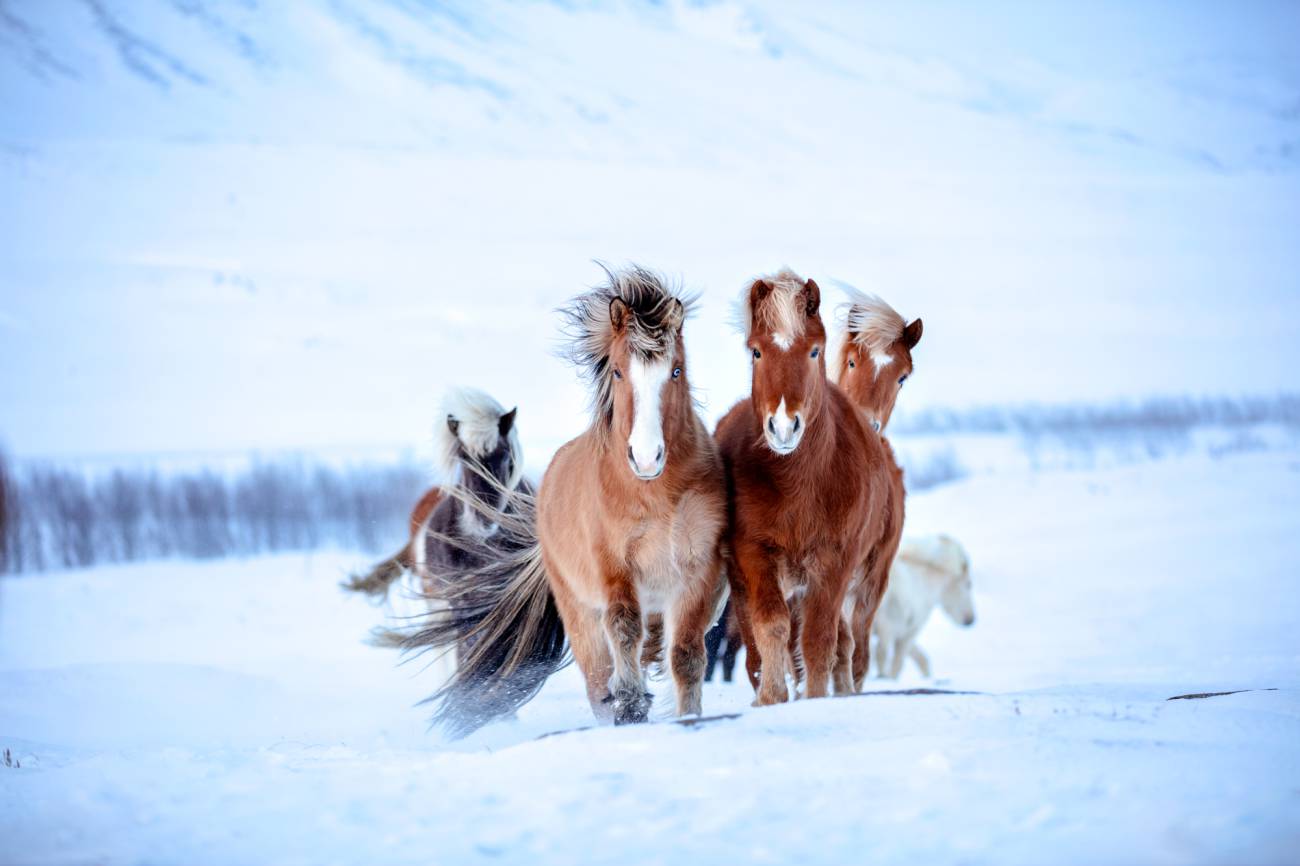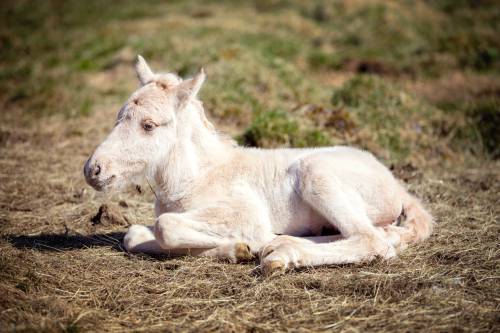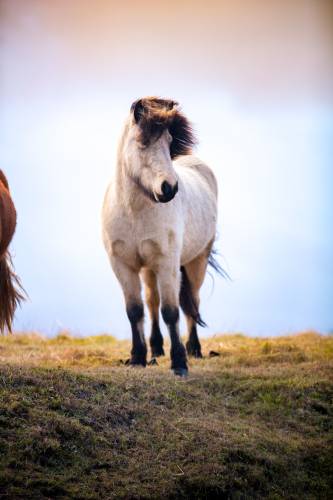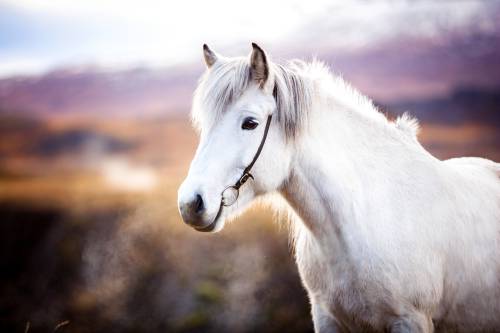Litur {Colors of the Icelandic horse}
Icelandic horses come in all colour variations, from black to earth colours to smoky and palomino.
There are two basic colours, meaning two different pigments in the horse hair, which define the original colouring of the fur. On top of that, there are a series of genes that are responsible for the many variations in the colouring.
The basic colours are chestnut (Pheomelanin) and black (Eumelanin „E“).
The genes are always specified in upper- and lower-case letters. An upper-case letter means that the gene is present, while a lower-case letter indicates that the gene is not existent. Genes are always specified in pairs, because there are always two present, one from each parent.
If the horse is black, the description of its genes will be as follows: eE, Ee or EE. In order to be black, at least one Eumelanin gene must be present. A chestnut horse does not carry Eumelanin (black pigment) so the colour description would be ee.
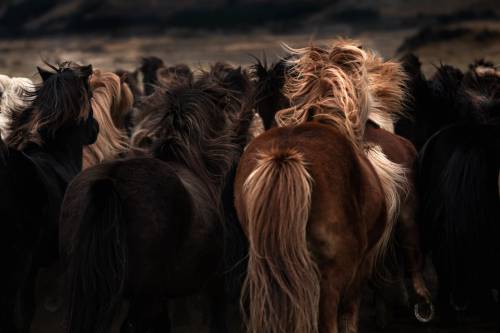
The bay gene (A)
Bay coloured horses have an additional gene, called Agouti (abbreviated “A”). This gene is responsible for lightening up the black body hair. This results in a black mane and tail while the body hair is brown. The lower half of the legs usually remains black as well. The colour description can be as follows: eEAa, EeAa, eEaA, EeaA (each has one Eumelanin gene and one Agouti gene), EEAa (two Eumelanin genes and one Agouti gene), EEAA (two Eumelanin genes and two Agouti genes).
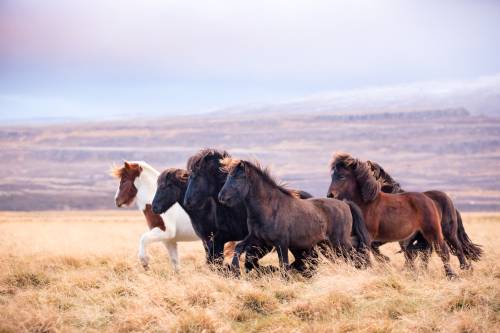
The grey gene (G)
Grey horses carry a gene that causes progressive silvering. If the horse has this gene, it will overlap all other genes. That means, regardless of what colour the horse has, it will eventually turn grey. Once the greying out has taken place, there will be no more pigments in the hair. This greying process can take a few months or many years. While the horse is not yet completely white, the colour is called dapple grey.
The cream gene (C)
The cream gene causes a lightening of the fur colour. A single gene lightens the basic colour of a horse only slightly. Two genes are responsible for very pale colours. Sometimes the horse seems to be almost white. The whitening effect of the cream gene is stronger with red pigments than with black ones.
Chestnut + 1 cream gene = palomino
Chestnut + 2 cream genes = cremellos
Bay + 1 cream gene = buckskin
Bay + 2 cream genes = perlino
Black + 1 cream gene = smoky black
Black + 2 cream genes = smoky cream
The dun gene (D)
The dun gene lightens all horse colours. The body is more affected than the head, therefore most dun horses have a dark “mask” on the face. They also always have an eel stripe, completely running through mane and tail.
Chestnut + dun gene = red dun
Bay + dun gene = bay dun
Black + dun gene = blue dun
The silver gene (Z)
The silver gene lightens only black pigments. This is especially true for long hair, which will be white as it has no pigments and is white.
Chestnut + silver gene = chestnut
Bay + silver gene = silver dapple bay
Black + silver gene = silver dapple black
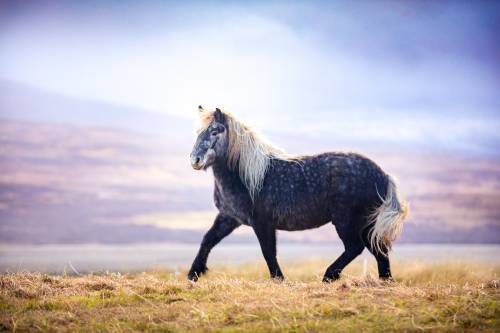
The paint genes (To and Spl)
Horses that carry piebald, also known as paint, genes have white fur, without pigments on parts of their bodies. These can be small spots or almost totally white horses. There are two different kinds of paints: tobianos (To) and splash (Spl), also known as overo. Tobianos usually have paints that start from the withers. A horse can carry one or two tobiano genes. This gene works similar to the grey gene: it is always visible. If a horse carries one tobiano gene, it will be a piebald. If the horse has two tobiano genes (ToTo) it will also be spotted.
Splash piebalds, also known as splashed white overo, look like their legs and head were dipped in milk. Depending on the amount of splash genes, one or two, the paints will be only slightly visible or very strongly. If the horse has only one splash gene, it is often difficult to recognize it as a splashed white horse.
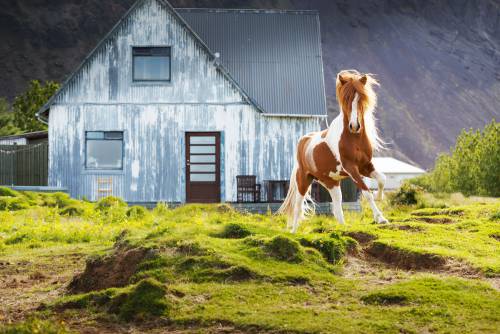
Text & Images: Eva Frischling
Exzerpt from the book “Lebensgefühl Island” / “Soul of Iceland”
Evas Website
Evas Instagram
Evas Facebook-Steite
A land of fire and ice, with more sheep than inhabitants, characterized by a unique nature! This is just a brief description of such a diverse country. While a volcano may erupt on one side of the country, you can hike a glacier, admire the Northern Lights, or take a bath in a hot spring on the other side of the country - at the same time.
This not only speaks for diversity, but also for spontaneity, which is also reflected in the changeable weather in Iceland. A popular Icelandic saying is "If you do not like the current weather, just wait for five minutes".
In contrast to this inconsistency, one thing is constant and that is the enthusiasm for Icelandic horses! The Vikings brought horses to the island in the 9th century.
To find out more about Iceland, you can find travelogues, reports, or interesting facts here in the UNDRA Journal!
